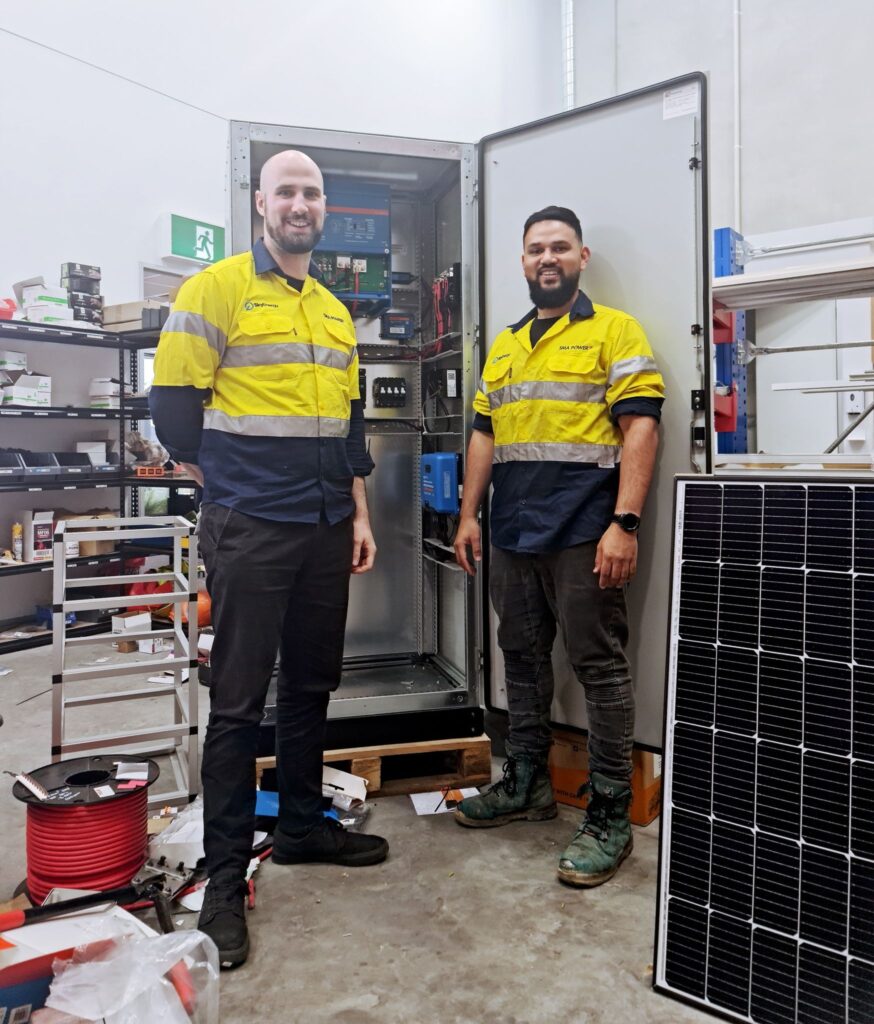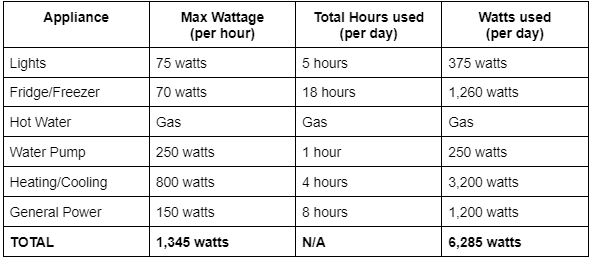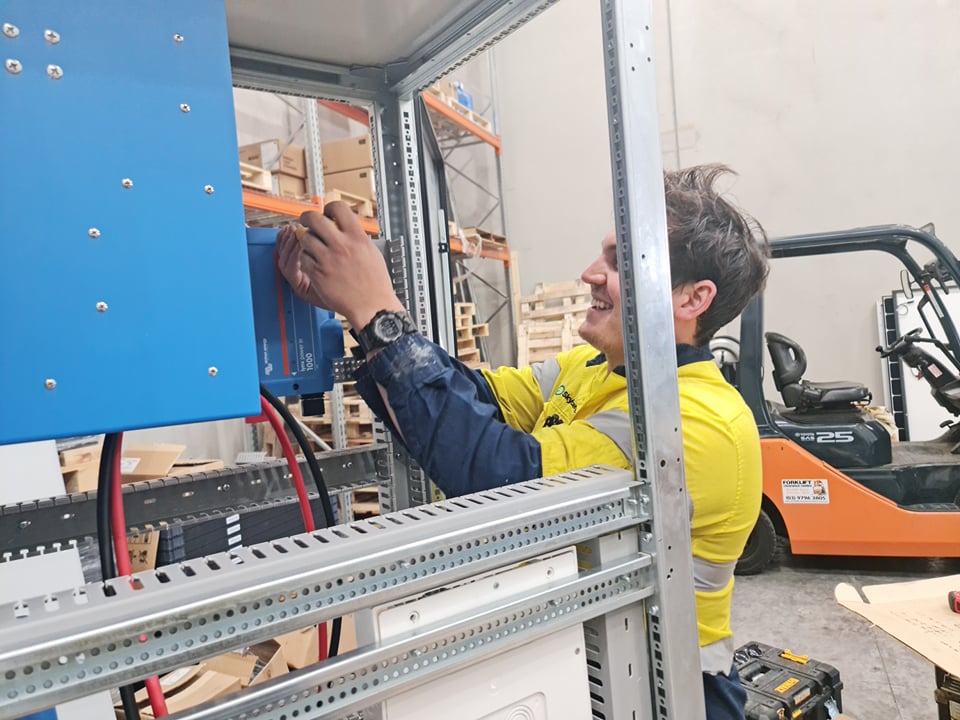
Power is one of the most (if not the most) important considerations when building your tiny home. After all, it’s the things like lighting and temperature control that can really make space truly feel like a home.
My name’s Sam, an electrician from Sky Energy, and today we’re going to have a look over some critical considerations for powering your tiny home. Being an Electrician, my guide will focus on how to power your tiny home almost entirely with electricity from solar and batteries rather than other possible fuel sources (like gas or mains power).
The appliances you use
Let’s start by looking at some of the most common appliances you’ll need and put together an example ‘power budget’. Most homes will need lights, a fridge/freezer, a few general power points, hot water, and perhaps a water pump. By adding together the energy profiles of the appliances you will need in your home, it’s possible to create an ‘energy budget’ to aid you in designing a power system to provide for your tiny home. The most important thing is to understand the general concept of building a power budget for your tiny home, this way you will be able to customise the system for your needs.
Keep in mind a tiny home can have an electrical grid connection, or it may be totally ‘off-grid. The guide below is to help you design a solar and battery system to cover your tiny home’s energy needs being ‘off-grid or, to draw up an energy budget before building your tiny house as a great way to ensure your solar and battery system is supporting all of your energy needs, even if you’re wanting a grid-connection option as a backup. Making your home greener, cheaper to run and even more self-sufficient.
Lights (75 watts)
Today LED lights are an extremely efficient power source. LED lights used in your tiny home will be about 15 watts each. Five LED lights will give you an energy usage of (5 x 15 watts) 75 watts.
Fridge/Freezer (70 watts)
A small, efficient fridge/freezer combo unit will consume about 70 watts.
Hot Water
Hot water is a heavy user of power. I’ve left it out of this guide as gas power is a much more efficient way to supply your hot water needs. If you want to calculate using electricity for hot water, the average instantaneous electric hot water system uses about 4,000 4Kw per hour. This is too much power for the average tiny home solar and battery system. It might be a viable solution if you turned it on and used the hot water for only a small window of time per day. Each hour you run the hot water system will cost you 4Kw of power approximately.
Water Pump (250 watts)
Efficient off-grid water pumps will run at about 250 watts. Standard water pumps will draw much more than this.
Heating/Cooling (800 watts)
General Power (150 watts)
General power consists of phone charges, TV, perhaps the kettle, maybe a fan or laptop charger and an exhaust fan or two. 150 watts should be plenty to cover these appliances.
In the example below, we now have our total max power of 1345 watts. That’s how much energy we’d use if everything was running for a full hour, however as this is not the case and things turn on and off, we next need to create an estimated usage time per appliance per day. This is because if you have 75 watts worth of lighting, these lights will use 75 watts per hour; therefore, we need to estimate the usage of each appliance over 24 hours. The table below will make this easier to understand:

You can see from our rough calculation that you’ll need about 6,285 watts or 6.29 Kilowatts (kW/h) per day. It’s worthwhile to remember almost half of this is made up of heating and cooling, so being able to manage your temperatures (by using more blankets or a fan, for example) will almost half your total energy usage for the day.
Calculating the size of the solar system
Next, we need to determine what size solar system we need to generate our 6.29 kW/h per day. Obviously, our solar system will produce a certain amount of power each day; this can be calculated by multiplying the size of your solar system (in kilowatts) by the estimated sunlight hours those panels will receive each day. Keep in mind 1 kilowatt (kW) is the equivalent of 1000 watts. In Australia, depending on where you are and on the time of the year, you will receive about four hours of full sunlight, on average, each day. Most tiny homes can fit a 2kW (or 2000 watt) solar system. Multiplying the four sunlight hours by the 2kW solar system gives us 8kW/h of power. In other words, on average, a 2kW solar system in Australia will produce about 8kW/h or 8,000 watts each day. More than enough to cover the 6.29kW/h required on an average day, with a little bit more to spare, which could be stored in batteries for a rainy day.
Calculating the size of your battery
To understand what size battery your tiny home will need, start with your power budget. In our example, you’re using 6.29kW/h per day. Let’s say half this usage was going to be used at night time, you would divide by two (half the power for the day and a half for the night), giving you about 3.15KW/h of nighttime usage. This means you’ll want to consider a battery that’s about 3Kw/h to get you through a night. If you wanted to have enough battery for two nights, and you know you’re using 3kW/h per night, just add an additional 3kW/h for the total amount of nights you’d like to be covered. In this example, 3kW/h power usage per night x 3 nights would give you 9kW/h; therefore, you’d need about 9kW/h of battery storage to last three nights. Again, being more conservative with heating and cooling would reduce your power requirement by half, meaning if you didn’t use much active heating and cooling, you’d be able to half the required battery storage.
Bringing it all together
Given the examples above, we now have our 2kW solar system (producing about 8,000 watts per day) and 9kW/h of lithium batteries, which is enough to get us through three nights. We also worked out that we’re using 6.29kW/h of power per day, meaning the 8kW/h we’re generating each day is more than enough to supply the home during the day and keep the batteries topped up.
Remember, these are general rules of thumb, and it can be handy to have a backup generator for those darker months during winter, when there may be minimal sun at all for a few days. Overall, solar and batteries is a highly efficient way to power your tiny home with 95% renewable energy.

